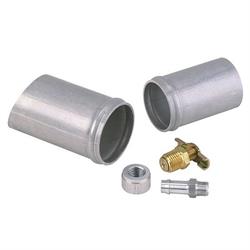Putting a 32 Radiator in a 29 Roadster
In this tech article I will outline the simple modifications required to fit a Speedway “full size” radiator in my traditionally built Model “A” Roadster running a Deuce grille shell. The reason I chose to write this article is because it has become quite common for customers to ask which radiator height they should purchase for their Model A project. Many times they want to run a ’32 grille shell on their hot rod. I can understand the reasoning because my car is ’29 Ford on Deuce rails running a ’32 steel shell as well and I struggled with the same question! There are a wide variety of radiators available and you can choose from aluminum or copper depending upon how much you want to spend. I am on a budget so I chose to go with Speedway’s Aluminum ’32 radiator because the price is unbeatable. They also receive excellent reviews from customers so that makes it a solid choice. These radiators come in three heights: 27” which is standard height, 22.5” which is slightly chopped, or 21” for cars with a sectioned grille shell. I like that the 27” has a dummy neck on the top so I can install a stock ’32 radiator cap. The smaller radiators do not have this provision. I also like that the full size radiator will fill up the hole in the shell giving me as much cooling area as possible. The only slight problem is this tall radiator doesn’t look quite right on a Model A roadster because it sticks up too high.
On a model A Ford mounted to a 1932 chassis there are various ways to get the radiator and grille shell lowered to match the height of the cowl. In the early days of hot rodding this wasn’t much of a concern and most cars built in the forties and fifties mounted the radiator as is without paying too much attention to subtle aesthetic issues. Modern builders hope to have a shell that appears as if it was designed to be there and not look cobbled together. Here is what I had to do to make my radiator fill up my shell, but also be low enough that it looks right.
I began with Speedway part number 9173423. It fits my reproduction steel shell perfectly. I drilled all of the mounting holes where they needed to be. This would be the perfect set up for a '32 Ford running a Chevy Small Block and no further work would be needed, just mount it and go!
I needed to tune mine a bit so the first order of business was to relocate the lower hose. Because the engine I am running in my hot rod is an early Hemi, the lower hose needs to be swapped from the Left side to the right. Speedway has a perfect little kit for this. I purchased part 91734465, which comes with a new inlet, outlet, and petcock.
I carefully cut the old lower neck off and filed it down smooth. I made a small patch to fill the hole and then welded it in place. Using a hole saw I cut a hole in the opposite side of the lower tank where I wanted the new neck to exist. Be careful not to cut the hole too big! Here it is better to start small and file it bigger with a round file to get it just right. I Tig welded the new neck in place, and located the new petcock right on the patch. Luckily I can still utilize the water temperature bung where it is so I didn’t have to change it at all. Because I am running a manual transmission and had my welder going I decided to weld the transmission cooler lines closed to clean up the look a bit.
With everything located where it needed to be I began looking at a way to lower the radiator mounting pads. There are two ways to achieve a lower radiator. One is by moving or changing the mounting pads, and the other is to cut into the mounting surface of the cross member itself. My car is utilizing a Model “A” front cross member and I didn’t feel like cutting into it given it is already welded into the frame. The good thing about the Speedway Aluminum radiators like the one I am using is they have aluminum mounts which can be cut and lowered easily. By doing what I did in the pictures below it dropped the radiator one inch. This brought it into perfect alignment with my cowl.
To achieve the 1” lower location I simply cut the vertical section out of the mounting flange and welded it back to the tank. It still provides a very strong mount, and sinks the radiator down into the contour of the front cross member. Whenever you cut on your brand new aluminum radiator just be careful and use care not to vibrate the radiator too much. Whenever I worked on mine I had it on an old memory foam mattress cover to protect the fins.
The only other detail I would mention is that any time you lower your radiator you have to trim up your '32 grille shell too! I feel good having a reproduction steel unit on my car because I didn’t have to tamper with an original. Just one inch removed from each side and it fit like a glove again!
This is just one way to tackle this problem. Because we receive many questions from customers building similar cars I wanted to at least give some visuals for how I adapted my radiator. With a little investment of time and energy I now have a custom radiator that is perfect for my combination!

